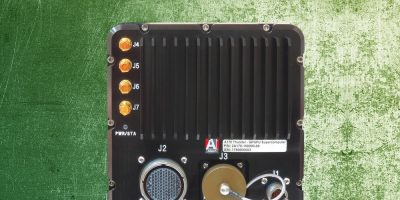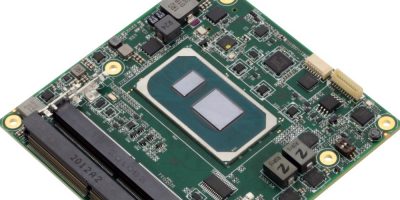Comprising 10 Renesas ICs, the scalable system-on-module (SoM) Smart Mobility ARChitecture (SMARC) Winning Combination board accelerates development of artificial intelligence (AI) IoT face/object detection, image processing, and 4K video playback applications, says Renesas. The board can be used in surveillance cameras, inspection equipment, and industrial and building automation HMI and embedded vision systems.
The 10 ICs include microprocessor (MPU), power and analog ICs. The board is based on the SMARC 2.0 industry standard, which specifies an 82 x 80mm form factor. The SMARC SoM board offers designers a choice of three different scalable versions of the Renesas 64-bit RZ/G2 MPU. Options are an RZ/G2N dual core Arm Cortex-A57 MPU operating at 1.5 GHz for mid-range performance; the RZ/G2M MPU with dual-core Arm Cortex-A57 and quad-core Arm Cortex-A53 (1.2 GHz) for high performance; and the RZ/G2H MPU with quad-core Arm Cortex-A57 and quad-core Arm Cortex-A53 for what Renesas describes as ultra-high performance. All three MPUs (two cores up to eight cores) feature integrated 600MHz PowerVR 3D graphics and a 4K UHD H.265 and H.264 codecs to satisfy the needs of different computer processing requirements.
DK Singh, director, of the Systems and Solutions team at Renesas, said: “Our scalable solution’s extensive on-board interfaces, large memory and programmable clocks for different needs makes it an excellent turnkey solution for a wide range of applications. And its industry leading RZ/G2 MPUs with 3D graphics engine and 4K UHD and full HD video codec provides higher performance per dollar than competing 64-bit MPUs and GPUs.”
The SMARC SoM offers designers their choice of RZ/G2 MPU with up to 35.6k DMIPS performance, between 2.0 and 4Gbyte LPDDR4 RAM and 32Gbyte eMMC. Each RZ/G2 MPU is capable of running edge video analytics and AI frameworks. The MPUs feature an integrated AI software library, a set of interfaces, error checking and correction (ECC) protection on both internal and external memories, Linux OS, and a Verified Linux Package (VLP) which is tested and maintained by Renesas. There is also a Civil Infrastructure Platform (CIP) Super Long-Term Support (SLTS) kernel, and a Linux kernel bundled with a software development environment. The SMARC SoM board provides an optimised power and programmable timing tree. There is also support for dual-band Wi-Fi and Bluetooth Low Energy (BLE) for wireless communication, fast communication interfaces such as USB, SATA, LVDS, HDMI, CSI, I2S, PCIe, and Gigabit Ethernet, all accessible through the SMARC 2.0 connector.
The board includes the ISL1208 low-power real time clock for calendar-based applications powered by a small 400nA battery, or supercapacitor during a power failure and the P8330 power management IC (PMIC) for delivering power to multiple supply rails.
Also included are two clock sources, Renesas’ small form factor VersaClock 3S programmable clocks with integrated 32.768kHz DCO powered by a single coin cell battery during a power failure and a PCIe clock generated with the Renesas 9FGV0641. This supports six 100MHz differential clock outputs, with PCIe Gen 1 to 4 support
There is also the option for connection to two external cameras and LCD panel with capacitive touch.
The Scalable AI SMARC SoM Winning Combo Solution board was designed by Renesas and developed through a collaboration with RelySys Technologies. The board and design files are available now.







